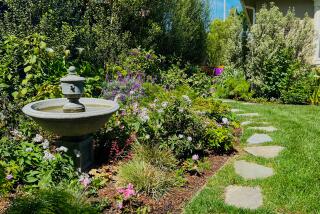Alcatraz, a blooming garden spot
Delicate flowers didn’t do well on the Rock. I’m not talking about prisoners, though criminals such as Al Capone and George “Machine Gun” Kelly were no shrinking violets. I mean the actual flowers blooming outside the cellblock walls — hot-pink foxglove, frilly valerian, even a deep-red climbing bloom dubbed the Alcatraz Rose.
They had to be extra tough to survive the island’s rocky soil and cutting winds, as well as 40 years of neglect after the federal penitentiary closed in 1963.
Of the 1.3 million annual visitors who take the ferry from San Francisco to Alcatraz Island, most come for the thrill of seeing where dangerous men were locked away. But once here — especially now, in spring and early summer — visitors will notice the island’s riotously blooming gardens. Even on the short walk from the ferry landing to the prison, the recently restored Main Road beds are rife with freesia, fuchsia and flame-colored African flag.
Just a few years ago, these beds were overgrown with weeds. But since 2003 the Alcatraz Historic Gardens Project has been working to restore the five gardens that comprise about four of the island’s 22 acres. The gardens burst with blooms that recall the softer side of Alcatraz.
Not bad for a barren, windswept rock that had most of its soil barged in.
Once a place of banishment for Ohlone Indians who violated tribal laws, the island was later claimed by Mexico. In 1848, the U.S. took possession, building a fort to house military prisoners and as a defense against foreign invaders. In the 1880s, Army engineers barged in soil from nearby Angel Island; seeds and spores — such as those of the California poppy and the goldenback fern — hitched a ride.
At the turn of the 20th century, there were already inmate gardeners; records show that in 1900, Jesse Adams escaped his cell to work in the gardens and then escaped the island entirely. He had himself nailed into a crate and shipped to the mainland.
In the 1930s, the warden’s secretary asked local plant breeders for seedlings that might do well on the island. Many came from the Mediterranean, such as the Pride of Madeira, a tall shrub with a cone of dense purple blossoms. More recently, volunteer gardeners have been reintroducing flowers that once thrived here but had died out, such as bachelor’s buttons and bush daisies.
Over the years everyone from Victorian wives to inmates to present-day volunteers have had their hands in the island’s soil. Docent-led tours are “full of inmate and resident gardening tales,” says garden project manager Shelagh Fritz, and even visitors who amble on their own will sense the ghosts of gardeners’ past.
After the Main Road beds comes the Rose Terrace, where from the 1920s to the 1950s inmates learned to plant, propagate and hybridize. In 2011, the terrace is again command central, with a greenhouse and the all-important compost heap. Here you may run into Dick Miner, the silver-haired “king of compost,” one of 117 volunteers who escape to Alcatraz to work in the gardens. (Volunteers last year put in nearly 8,000 garden hours.)
Next is Officers Row, which once nurtured a formal Victorian garden and has been restored to a charming walled enclave replete with iris, daffodils and heirloom roses. In 1989, rosarians discovered that one rose — the Bardou Job — had originated in Wales but was no longer found there.
In 2000, after decades of being confined to Alcatraz, six plants made their way back to Wales amid much fanfare. That hybrid tea rose is now also known as the Alcatraz Rose.
Up a short hill is the Warden’s Garden, with a commanding view of downtown San Francisco. According to a historic photo, the wife of one warden would tend her plants dressed in a smart frock and high heels. Down the hill is a jumble of rubble on what used to be the military parade grounds, debris from decades of collapsed outbuildings now overrun with ivy, honeysuckle and blackberries.
The last and westernmost garden is also the most poignant; this was the only green most inmates ever saw, on the heavily guarded walk from their cellblock to their prison industry jobs. Now as then, heirloom succulents climb the hill to what was the exercise yard. Fig trees flank the way, and nestled within orderly tiered beds is a garden shed built in the 1940s by prisoner 578, Elliott Michener, convicted counterfeiter.
The shed still stands; from its windows is a clean sweep of blue all the way to the Golden Gate Bridge. Michener became an avid gardener here; legend has it that he stuck around even after being paroled, unwilling to leave his beloved gardens. Modern-day visitors might feel the same, so caught up in the Rock’s living legacy that they forget all about the cellblock tour.
More to Read
Sign up for The Wild
We’ll help you find the best places to hike, bike and run, as well as the perfect silent spots for meditation and yoga.
You may occasionally receive promotional content from the Los Angeles Times.






